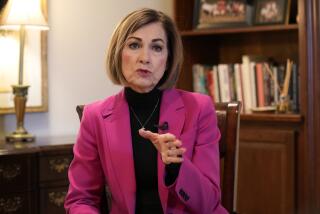Seniors would pay the price of Ryan’s plan to overhaul Medicare
We’ve been hearing — and will continue to hear — a lot about how Paul Ryan’s plan to overhaul Medicare and Medicaid would cripple the safety-net healthcare programs.
Fair criticism? The answer, as Bill Clinton might say, depends on what your definition of “cripple” is.
The Ryan plan has been around for months. It’s taken on new heft since Ryan, a conservative congressman from Wisconsin, was tapped over the weekend by Republican presidential candidate Mitt Romney to be his running mate.
President Obama’s deputy campaign manager, Stephanie Cutter, said onCBS’ “Face the Nation” on Sunday that Ryan’s plan “would be the end of Medicare as we know it.”
Romney responded during a Florida appearance Monday that he and Ryan “want to make sure that we preserve and protect Medicare.” He said of the charges made by the Obama campaign that “it’s smear, it’s dirt, it’s distortion, it’s deception, it’s dishonesty.”
It’s also true.
Ryan’s plan would provide a federal subsidy to people now 55 and younger to opt out of Medicare and purchase private insurance instead. Critics have dubbed this a voucher program.
Alain Enthoven, a professor emeritus at the Stanford Graduate School of Business who served as a consultant to the Carter administration on healthcare issues, told me the Ryan plan is misunderstood.
“What Ryan is trying to do is give everyone an incentive to behave in a more economical way,” he said.
The plan, Enthoven explained, would entail Medicare competing against private insurance plans. People would receive a federal subsidy pegged to one of the lower-cost private plans.
If you want more expensive coverage — good old Medicare, say — you’d have to make up the difference in annual premiums.
If you pick a cheaper plan than the amount of the subsidy, you could pocket the savings.
“It’s wrong to convey the idea that people will receive some kind of coupon and then go out and see if they can find insurance,” Enthoven said. “The insurance would be there. But you would have an incentive to hold down costs.”
Perhaps, countered John Holahan, director of the Health Policy Center at the Urban Institute, a nonpartisan Washington think tank. But it’s not clear that the changes would result in more affordable or comprehensive health coverage for seniors.
“Ryan’s plan has the potential to do a lot of harm and not much to actually control healthcare costs,” Holahan told me.
A key problem, he said, is that healthcare costs could rise faster than the size of the federal subsidy. Ryan’s plan would set the amount that people would receive annually at the cost of the second-least-expensive private insurance plan available.
Increases in the amount of the subsidy would be capped at annual growth in gross domestic product plus 0.5%, with possibly other adjustments based on an individual’s income level.
Let’s look at how that plays out in the real world. Last year, America’s GDP grew by just 1.7% (well below the historical average of 3.3%). Under Ryan’s plan, therefore, seniors’ healthcare subsidy for 2012 would rise by 2.2%.
Why anyone would peg healthcare subsidies to GDP is beyond me. Healthcare costs have far outpaced economic growth for years.
Private health insurers and Medicare paid an average 5.8% more per person for healthcare services in the last year, according to Standard & Poor’s Financial Services.
The growth in costs becomes even more significant when private coverage is separated from the federal plan. Private insurance costs rose 7.7% last year, S&P; determined, while outlays under the heavily regulated Medicare program increased just 2.7%.
“I don’t think there’s any reason to believe that private insurers can offer a more competitive rate than what Medicare offers for the same level of coverage,” Holahan said. “They’ll either have to charge more or offer less coverage.”
The bottom line: Some private plans would almost certainly be cheaper than Medicare, but they’d offer less coverage to keep costs down. If a senior wanted to stay with Medicare, he or she would have to pay more out of pocket than provided by the federal subsidy.
In other words, a greater share of the federal program’s costs would shift to beneficiaries.
The effect on Medicaid is potentially even more troublesome. The program for low-income people is currently funded by both the federal government and states. The more people who sign up, the more money that must be allocated.
Ryan’s plan would change that. It would have Uncle Sam provide states with a limited “block grant” of Medicaid funds that states would be free to use as best they can.
This more efficient use of money would reduce Medicaid spending by about $810 billion over 10 years, Ryan estimates. By 2022, federal Medicaid funding would be roughly a third less than states would have received under current law, according to an analysis by the nonpartisan Center on Budget and Policy Priorities.
Stanford’s Enthoven said this cutback in funds would force states to be more creative in addressing the healthcare needs of low-income people. It would also curtail abuse of the system, he said.
“Medicaid has become a great big game by states to get more and more money from the federal government,” Enthoven said. “We need to change the incentives.”
But Holahan at the Urban Institute said the true upshot would be less money available to cover low-income people’s medical needs — particularly in tough economic times like these, when demand for Medicaid coverage increases.
“States would either have to cut people off or they’d have to raise taxes to cover the difference,” he said.
There’s no question that reform of Medicare and Medicaid is necessary. The programs are simply unsustainable in their current form and with millions of baby boomers coming down the pike.
Points to Ryan for having the chutzpah to put something on the table.
But cutting back on Medicaid, or Medi-Cal as it’s known in California, won’t do much to improve things. The only alternative for many low-income people would be to show up at emergency rooms, which would result in higher rates and taxes for others.
As far as Medicare is concerned, I don’t think there’s much evidence that the private sector has the best interest of patients at heart. Ask yourself: Does your insurance provide the level of coverage you desire at an affordable rate? Are you confident your private insurance will meet your needs in the future?
Most other developed nations offer a Medicare-for-all program that spreads healthcare risks evenly among members of society. If Ryan’s plan were to be adopted, the United States would move even further from a goal of universal coverage.
In that sense, if in no other, it’s fair to say that it would end Medicare as we know it.
And I’m not sure that’s an improvement.
David Lazarus’ column runs Tuesdays and Fridays. He also can be seen daily on KTLA-TV Channel and followed on Twitter @LATlazarus. Send tips or feedback to david.lazarus@latimes.com.
More to Read
Start your day right
Sign up for Essential California for news, features and recommendations from the L.A. Times and beyond in your inbox six days a week.
You may occasionally receive promotional content from the Los Angeles Times.







